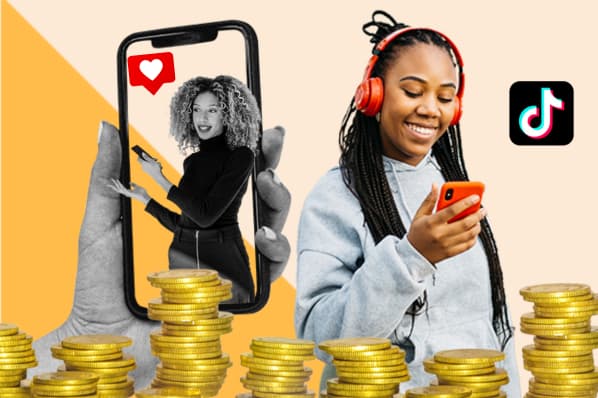Social Media Marketing
When I was growing up, QVC was the channel my mother would watch to discover new products and deals. From hair straighteners to trendy blouses to jewelry, QVC would display everything during its 24/7 live broadcast. Fast-forward to 2024, and I thought the live QVC era was long gone, thanks to the rise of online shopping. However, it looks like it is making a comeback via TikTok Live Shopping. I can’t scroll for more than a minute without coming across a TikTok Live event showcasing products and services that viewers can purchase directly from the live broadcast. So what is TikTok Live Shopping, and is it the new QVC? More importantly, should your brand give it a try? Here‘s what I’ve found: What is TikTok Live Shopping Why should brands experiment with TikTok Live Shopping? TikTok Live Stream Shopping vs. QVC What is TikTok Live Shopping? TikTok live shopping allows
This year, global social media users swelled to a record-breaking 4.9 billion. Statistics like these suggest that social media stocks may be a great investment opportunity — but what are the best social media stocks to invest in? Social media is big business. One recent report valued the industry at a whopping $231 billion. It’s also an incredibly complex market, with countless platforms, technologies, and companies all doing their best to stay competitive in this rapidly evolving space. This article explores how to invest in social media stocks, what social media can tell us about the broader economy, and which are the top social media stocks to watch in 2023. What are social media stocks? Should you invest in social media stocks? What Social Media Stocks Tell Us About the Economy Social Media Stocks to Watch What are social media stocks? Of course, to craft an effective social media investment
In July 2023, Mark Zuckerberg launched Meta’s much-anticipated X competitor: Threads. Meta’s vision for this new social platform was to offer “a new, separate space for real-time updates and public conversations” that was built on the foundation of Instagram’s existing community, content, and infrastructure. As explained in Meta’s official announcement, “Threads is to take what Instagram does best and expand that to text, creating a positive and creative space to express your ideas.” Like Instagram, you can follow friends and creators who share your interests. Of course, Threads has received its fair share of criticism, from accessibility concerns to accusations of using “dark design” tactics. Nevertheless, Threads hit more than 30 million sign-ups in its first 16 hours alone. It’s continued to gain traction since then, demonstrating the strength of the app’s design. In this article, we’ll cover the design choices that have helped Threads go (and stay) viral, the
We have an epic showdown in the thrilling world of social media warfare. It’s X vs. Threads, the battle of short-form social media. In one corner, we have X, the reigning short-form post champion embroiled in drama and controversy. In the other corner, we have rookie Threads, who’s betting big on user control and wants everyone to play nice. Can X maintain its dominance and keep you scrolling for more? Will Threads promise a better, safer platform for public conversations? The X vs. Threads story includes leadership takeovers, a sizable user departure, and a record-shattering launch. Shaking off the dust of the past, we’re here to answer the most crucial question for you and your brand for the future: Which one should you use? X vs. Threads: What’s the difference? What is X? What is Threads? Which should you use – X or Threads? X vs. Threads: What’s the difference?
Threads launched in the summer of 2023 and was almost immediately dubbed the “Twitter Killer” and was projected to be a strong competitor to the newly named X (formerly Twitter). All the hype at the start of Meta’s newest property may have you wondering, “Should my business use Threads?” Social media apps come and go, plus time is precious in the marketing world, so you’re probably hesitant to try expanding your brand on such a new platform. Here are some benefits and concerns surrounding Threads to provide clarity and help you make the decision that best aligns with your business. Pros & Cons of Instagram’s Threads There are benefits to having a Threads account for your business. However, the platform is still very new and has some drawbacks. Pros of Threads Instant Following Since Threads connects to your Instagram account, your followers from Instagram are transferred to Threads — so
Threads, Instagram’s text-based conversation app, launched in July 2023 and reached 100 million active users within ten days. It grew five times faster than ChatGPT, the previous record holder for the fastest-growing app. Its initial spike in popularity reportedly caused a drop in Twitter’s (now X) traffic—it was an exciting app for consumers to try out amidst X’s growing controversies. Despite its initial success, will Threads meet the same fate as many other young social media platforms? Is Threads losing steam? SimilarWeb reported that Threads usage was down 79%, and time spent on the app was down 89% just one-month post-launch. While U.S. users once spent 21 minutes on the app per day, it dropped to three minutes by August 7th. What’s more, the user base fell by more than half since launch. Image Source This data does show that Threads’ initial surge has certainly died down. Consumer perspective is
In today’s digitally connected world, social media platforms are constantly evolving. Among the frontrunners is Threads, Instagram’s newly-developed social media hub. Post-launch, Threads quickly gained traction as one of the fastest-growing social platforms for 2023. While the initial buzz may have faded, Threads still remains an untapped goldmine for marketers looking to elevate their social media strategy. But what does it actually do and, most importantly, why is it still a powerful tool in your marketing arsenal? Well, kick back, read on, and allow us to explain. Table of Contents: Overview of Instagram Threads How to Set Up a Threads Account How to Use Threads (& What to Post) Brands to Follow on Threads Overview of Instagram Threads Threads allows brands to connect, curate, and quickly share content. It has rapidly gained popularity — due in part to its focus on providing a simplistic, casual approach to social media. With
Creators and users on the app formerly known as Twitter can now earn money thanks to a new program rollout. X’s new ad revenue-sharing feature is the latest change to come to the platform after the social media site was acquired by Elon Musk and rebranded as X. To access the program, users must subscribe to X Premium, previously known as Twitter Blue. So, is X‘s take on creator pay worth paying for X Premium? How much are creators earning with the new ad revenue-sharing program? Let’s dive in. What is X’s Ad Revenue-Sharing program? What do creators think of X’s Ad Revenue Sharing Program? Should creators subscribe to X Premium? What is X’s Ad Revenue-Sharing program? X‘s ad revenue-sharing feature allows users to share in the earnings generated by ads displayed in the replies of the user’s content. For instance, if I post content on X and there is
Nowadays, it seems like new social media platforms are cropping up while older ones crumble. Think about how the fall of Vine gave way for Instagram videos to gain popularity and how many Vine content creators had to pivot to platforms like Instagram and, later, TikTok. Social media influencers and content creators must always be ready to jump to new platforms or incorporate them into their marketing strategy. This article will discuss seamlessly switching platforms as content creators or influencers while retaining momentum and gaining new followers. 7 Tips for Switching Platforms as a Creator Go where your audience is. Make your new platform recognizable. Be consistent. Inform your audience. Post valuable content. Collaborate with other creators. Repurpose content. 7 Tips for Switching Platforms as a Creator Below are tips from content creators with experience pivoting to new social media platforms. Go where your audience is. Podcaster Jacqueline Snyder of
When the COVID-19 pandemic began, many consumers raced online to buy products they couldn’t get in-store. And, by July 2020, global retail ecommerce sites cumulatively saw a record 22 billion monthly visits. Shopping on social media rose in popularity as well, allowing businesses to sell more items directly from their existing profiles. Now, most platforms offer native shopping tools, but, as with any new trend, you might wonder, “Are consumers actually shopping on social media?” The question is worth asking, and we’ll answer it in this post. Table of Contents Do consumers actually buy products on Social Media? Which social media platforms are consumers really shopping on? Which social platforms should you sell on? Do Consumers Actually Buy Products on Social Media? There are now more ways than ever to buy products on social media. But, since some social media shopping tools are still rather new to shoppers and brands







